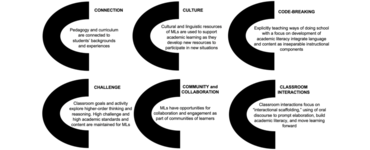Learning a language is a lifelong process. Therefore, it is essential to transform an assessment into a moment of learning and joy. To reach this goal, Directed Motivational Current (DMC) theory (Muir & Dörnyei, 2013) was successfully experimented in a Malian English as a Foreign Language classroom in order to intentionally generate the learners’ motivation and push them to surpass themselves during an assessment so that successful learning could take place. The results revealed that the learners experienced an intense motivational level that stimulated an exceptional interest in the assessment instrument.
Key words: Directed Motivational Currents, motivation, assessment, oral presentation project, intense
What happened in my teaching context?
Language assessment is a significant element in the process of teaching and learning. Its outcomes are normally used to improve teaching and learning processes, but in my teaching context, specifically Mali (a West African country) where English is learned as a compulsory foreign language from the seventh grade to university, teachers and the school administrations consider an assessment as their sole property. They use the outcomes of an assessment to make administrative decisions such as validating a course credit. They are rarely utilized to improve the teaching and learning process. As a result, an assessment may increase social inequity instead of minimizing it as claimed by certain specialists in the field of evaluation such as Darling-Hammond (1994). In addition to these issues, most of the Malian English teachers mainly use grammar translation as a method to teach English to their learners. Therefore, during the assessment, these teachers use decontextualized tests (such as multiple-choice questions, true or false questions, matching, and translation from French to English or vice versa) to measure their learners’ competencies. As this way of assessing does not take into account learners’ communicative skills such as written and oral productions, oral interactive tasks, problem solving activities, and project work, it is difficult for the teachers to offer quality feedback to their students. Besides, decontextualized tests may not have a high washback. According to Brown and Abeywickrama (2010), washback is the positive or negative impact that testing has on learning and the teaching process.
Certain Malian English learners are so demotivated that they consider the English language to be a mirage that they will never reach unless they go to inner circle countries such as Canada, Great Britain, the United States of America, or to some African anglophone countries (e.g., Ghana, Nigeria, or South Africa). Additionally, going to these countries increases the social barriers and promotes exclusion because most of the Malian English learners who are attending public schools are from poor and middle-class families. Most of them cannot afford to go to these English-speaking countries. In the case that they have financial means, obtaining a visa may be another obstacle to their English learning abroad.
All of these issues motivated me to apply for the Fulbright Scholarship. I learned about this prestigious scholarship thanks to one of my role model professors who was also a Fulbright alumnus. It is worth mentioning that the Fulbright selection process is highly competitive because each candidate is supposed to obtain at least 80 out of 120 on the TOEFL Internet-Based Test (iBT) so that their application can be considered for the final selection. In 2013, my dream became true and I was sent to Minnesota State University, Mankato where I majored in Teaching English as a Second Language (TESL).
For my first semester there, I was hypnotized by my professors’ ways of personalizing their feedback and nurturing their students. Long and anxious traditional timed tests were over and these professors considered different learning experiences as course assessments. Projects were also adapted to students’ lives outside of school. This attention was so unique and new for me that I called TESL my ‘little refuge’. As a result, my Master’s thesis focused on the topics of performance-based assessment (PBA) and motivation. PBAs, which are also referred to as authentic assessments or performance assessments, “require students to accomplish approximations of real-life authentic tasks, usually using the productive skills of speaking or writing but also using reading or writing or combining skills” (Brown & Hudson, 1998, p. 662). Data were collected from 25 English learners using pre- and post-project motivation questionnaires to explore their motivational responses to a PBA, specifically an oral presentation project done in small groups. The results indicated that these participants responded positively to an oral presentation project done in small groups. Their test-taking anxiety was also maintained at an optimal level, so it did not interfere with their overall production (Koné, 2015). Other researchers from the English as a Foreign Language (EFL) context such as Birjandi and Tamjid (2010), Fook and Sidhu (2010), Nier, Silvio, and Malone (2014), and Zohoorian (2015) also found that PBA had a positive impact on the learning and teaching process. Stefanou and Parkes (2003) additionally argued that a PBA can lead to higher motivation and greater interest in an activity. PBA further motivated learners to stay focused and engaged (Koné, 2015). Based on these positive results, I was curious to figure out my learners’ motivational reactions to a PBA activity, specifically an oral presentation project framed within a Directed Motivational Current (DMC) theory perspective.
What did I do to make changes in my teaching context?
Although changes did not happen overnight, I decided to use a framework for focused intervention in my EFL classroom that involved 60 first-year students who would be working in small groups of four or five (Dörnyei, Henry, & Muir, 2016). Among them, there were 25 female students and 35 male students whose ages ranged from 17 to 21. There were 13 groups (eight groups of five students and five groups of four students). These students were attending the Professional and Technical Teacher’s Training School in Bamako, the capital city of Mali. They were majoring in communication and office work. Before explaining how I applied such a robust theory in my EFL classroom, it is worth defining a DMC.
According to Dörnyei, Henry, and Muir (2016), Ibrahim (2016), Ibrahim and Al-Hoorie (2019), Muir (2016), and Muir and Dörnyei (2013), DMCs are an intense motivational surge that goes beyond the motivational level of a highly and intrinsically motivated student. This heightened motivation is so intense that it can support second language learning for a long time (Dörnyei et al., 2016). DMCs can last for a week or even years, but they are finite (Dörnyei et al., 2016). Dörnyei et al. (2016) proposed a teaching methodology called project-based learning and framework variants that can be used to apply DMCs in a language classroom. Among these framework variants, I have used a combination of That’s Me! and All eyes on the Final Product to trigger my EFL learners’ DMCs. A project organized around a That’s Me! framework has a strong connection with learners’ identities and lives. In other words, it values them as learners and takes their needs and particularities into account (Dörnyei et al., 2016; Muir, 2016). It additionally allows them to have their own voice and work on a topic that increases their curiosity and passion. A good example of a project reflecting the That’s Me! framework is the Freedom Writers Diary, a best seller of The New York Times. The Freedom Writers Diary project gave voice to some students who were labelled as low-achievers to be heard on the world stage. They wrote about their lives, dreams, fears, and hope in a journal, and the classroom teacher responded to their entries. Finally, giving learners the opportunity to present their project outcome to a real audience increases its authenticity.
Regarding a project built around the All eyes on the Final Product framework, this gives learners the opportunity to work on a real-life project and present its outcomes to a real audience (Dörnyei et al., 2016; Muir, 2016). To achieve this aim, the goal of a project must be clear with a strong vision so that learners can be involved in it from the beginning to the end (Muir, 2016). Creating a blog or making a video are examples of projects that reflect an All eyes on the Final Product variant (Dörnyei et al., 2016). Learners should use their second language to record the experiences related to their project work in a journal for each framework variant mentioned previously. To adapt my project to some of the requirements of these frameworks, I allowed the learners to choose their own topics in relation to their specific field as seen in Table 1.

The project was named Free Topic Oral Presentation and it spanned over six weeks. The class met twice a week and each course lasted two hours. Table 2 offers a thorough description of the course and the project.

Concerning the learners’ reflective comments written in their journals, I paired groups to minimize the workload. For example, Group 1 wrote comments for each member of Group 2. Each week, I read their reflective comments and provided them with feedback as decided at the beginning of the project. In a DMC, this step is called a “progress check” (Dörnyei et al., 2016). In the journal, there was a section called My Course. In this part, each learner was allowed to write about their impressions ranging from their motivation, the teaching and assessment techniques used by the teacher, the classroom environment, to anything miscellaneous related to the course that they would like to share.
What did I find in the learners’ reflective journals?
I read the students’ reflective journals and interpreted the data based on the number of references to a theme. I also checked if the markers of group-DMCs were present. It is worth noting that a colleague of mine helped me analyze the data and classified them based on the number of references to a theme. Some students’ comments were also selected based on their relevance and clarity to illustrate each theme. However, this does not mean that the other samples were not useful. Table 3 shows the various themes that were chosen based on the interpretation of the data extracted from the learners’ reflective comments. The number of references is between parentheses.

Based on these results, it can be said that these learners were caught up in the flow of group-DMCs. This happened because of the teaching methodology and the combination of the framework variants that were used to design the project. The launch of the DMCs was difficult, but it happened once the various groups matured and became cohesive. These findings parallel the study by Ibrahim (2016), which indicated that the group maturity is a sine qua non in order to generate a group-DMC. Ibrahim also confirmed that a cohesive group with positive group norms was conducive to facilitating a group-DMC. The difficulties observed at the beginning of the project can be explained by the learners’ non-familiarity with project-based learning and oral presentations. One needs to know that the grammar translation method is widespread in this teaching context as explained earlier. Therefore, transitioning from one method to another may be challenging for certain learners as argued by this student in his reflective journal:
“This was my first time to speak much English and do an expose [oral presentation]. I was anxious and said how can I do this. I never work like this. I learn my lessons by heart and during the exam I recite [recall] them, but Madam asked us to work like professionals and this was difficult. I really really worked hard with my group. But my teacher helped and at end I became confident and I plunged myself in it.”
As I was familiar with this teaching method, I had regular conferences with the learners upon request in order to help them reach their goals and provide them with quality feedback that could help them achieve the goals set for the project work. Having conferences with learners and providing them with quality feedback is an integrative part of DMCs and project-based learning (Dörnyei et al., 2016). It additionally increases the positive impact that teaching may have on the learning process if learners consider the feedback given by the teacher while improving their ongoing projects. It can be deduced that this was the case for this project because the students mentioned most of the characteristics of a DMC as noted by this learner while reflecting on his oral presentation:
“I had never worked like this. I was so strong and powerful. I think I could do all the things I like. I was like fly in the air. I was not heavy and I could understand new things easily. I was not afraid of working even if it was sometimes challenge [challenging] and hard. If I can be like this all the time I will speak English in one year like an Anglophone. I want to revive this again and again because I want to speak English.”
When learners are caught up in the motivational flows, they establish routines such as reading books in the second language in order to achieve their learning goals. These routines may be so automatic that they will become an integral part of the learning process and will no longer require an explicit effort. Once the currents start waning, some people may feel nostalgic about their lived experiences. Accordingly, a teacher should help their learners set new learning habits to value the DMC experiences and to facilitate a smooth transition from an energetic state to a normal motivational level.
My impressions
Based on this classroom project, it can be concluded that the Malian EFL learners can experience purposefully generated DMCs. Additionally, while caught up in the flow of DMCs, these learners showed that they could learn and speak their English in Mali. This new motivational state empowered them and increased their motivation so that successful EFL learning could happen. The teacher’s familiarity with project-based learning also made the classroom environment friendly and supportive as claimed by this student:
“To know that Madam was with us not against is important. She was not in the class to give us bad notes or traumatize students. She helps us to learn and speak English. She sit [sits] near us and discuss as a family. I really like this of her.”
The title of the article was inspired by this student’s comment. Furthermore, this proves that these learners used to view an assessment as a moment of torture and stress. They seemed not to consider it as a component of their learning. The results of this classroom-based research demonstrated that PBA, specifically project work, can be one of the solutions to the assessment issues in the Malian EFL context. However, teachers there can also explore other assessment methods in order to decrease their learners’ test-taking anxiety and transform their assessment into a moment of learning and enjoyment. Researchers from other teaching contexts should experiment with the DMC theory in their language classrooms because motivation matters, as it is one of the key predictors of successful language learning.
References
Birjandi, P., & Tamjid, H. N. (2010). The role of self-assessment in promoting Iranian EFL learners’ motivation. English Language Teaching, 3(3), 211-220. https://doi.org/10.5539/elt.v3n3p211
Brown, H. D., & Abeywickrama, P. (2010). Language assessment: Principles and classroom practices. (2nd ed). Pearson Longman.
Brown, J. D., & Hudson, T. (1998). The alternatives in language assessment. TESOL Quarterly, 32(4), 653-675. https://doi.org/10.2307/3587999
Darling-Hammond, L. (1994). Performance-based assessment and educational equity. Harvard Educational Review, 64(1), 5-30. https://doi.org/10.17763/haer.64.1.j57n353226536276
Dörnyei, Z., Henry, A., & Muir, C. (2016). Motivational currents in language learning: Frameworks for focused interventions. Routledge.
Fook, Y. C., & Sidhu, K. G. (2010). Authentic assessment and pedagogical strategies in higher education. Journal of Social Sciences, 6(2), 153-161. https://doi.org/10.3844/jssp.2010.153.161
Ibrahim, Z. (2016). Directed motivational currents: Optimal productivity and long-term sustainability in second language acquisition (Unpublished doctoral thesis). University of Nottingham. Retrievable from http://eprints.nottingham.ac.uk/33489/
Ibrahim, Z., & Al-Hoorie, A. H. (2019). Shared, sustained flow: Triggering motivation with collaborative projects. ELT Journal, 73(1), 51-60. https://doi.org/10.1093/elt/ccy025
Koné, K. (2015). The impact of performance-based assessment on university ESL learners’ motivation (Unpublished master’s thesis). Minnesota State University, Mankato. Retrievable from https://cornerstone.lib.mnsu.edu/etds/402
Muir, C. (2016). The dynamics of intense long-term motivation in language learning: Directed motivational currents in theory and practice (Unpublished doctoral thesis). University of Nottingham. Retrievable from http://eprints.nottingham.ac.uk/33810/
Muir, C., & Dörnyei, Z. (2013). Directed motivational currents: Using vision to create effective motivational pathways. Studies in Second Language Learning and Teaching, 3(3), 357-375. https://doi.org/10.14746/ssllt.2013.3.3.3
Nier, V. C., Silvio, F. D., & Malone, M. E. (2014). Beliefs about assessment and language from Arabian instructors and students. The NECTFL Review, 73, 56-76.
Stefanou, C., & Parkes, J. (2003). Effects of classroom assessment on student motivation in fifth-grade science. The Journal of Educational Research, 96(3), 152-162. https://doi.org/10.1080/00220670309598803
Zohoorian, Z. (2015). Motivation level: A study on the effect of an authentic context. Procedia – Social and Behavioral Sciences, 192, 15-25. https://doi.org/10.1016/j.sbspro.2015.06.003









